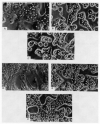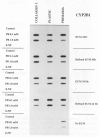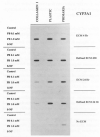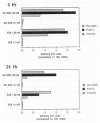Effect of Tissue-Culture Substratum and Extracellular Matrix Overlay on Liver-Selective and Xenobiotic Inducible Gene Expression in Primary Rat Hepatocytes
- PMID: 24817786
- PMCID: PMC4012392
Effect of Tissue-Culture Substratum and Extracellular Matrix Overlay on Liver-Selective and Xenobiotic Inducible Gene Expression in Primary Rat Hepatocytes
Abstract
In a previous study (Sidhu et al., 1993), we demonstrated that a combination of certain cell culture media, hormone addition, and extracellular matrix (ECM) overlay coordinately modulated the expression of certain liver-selective genes in primary rat hepatocyte cultures, including the responsiveness of genes to phenobarbital. However, little is known about the interactions between the type of substratum upon which hepatocytes are adhered and the ECM overlay, as codeterminants of liver-selective gene expression. The present study was undertaken to compare specific substrata, including tissue culture-grade plastic, Primaria, and type 1 collagen-coated plastic, in combination with the presence or absence of standard ECM or a growth-factor-reduced ECM overlay. Hepatocyte cultures were assessed either as control cultures or subsequent to treatment for 24 h with phenobarbital (0.1 or 1 mM), or beta-naphthoflavone (22 μM), to monitor responses of hepatocytes to two prototypic gene-inducing agents. Analyses of maintenance and induction of cytochrome P450 and liver-selective gene expression included measures of mRNA levels using Northern blot and slot-blot hybridization and single cell immunofluorescence assays to measure levels of specific cytochrome P450 proteins. The results of these experiments demonstrated that hepatocyte-selective expression, including the absolute level of induction response (relative to those observed in the rat liver in vivo) was highly dependent on the presence of ECM overlay but independent of the substratum employed. As studied herein, the establishment of optimal conditions for primary hepatocyte culture, enabling reproduction of responses observed in vivo, is important to further prospects for in vitro toxicity testing and for investigating molecular mechanisms of phenobarbital-mediated gene regulation.
Figures











Similar articles
-
Influence of extracellular matrix overlay on phenobarbital-mediated induction of CYP2B1, 2B2, and 3A1 genes in primary adult rat hepatocyte culture.Arch Biochem Biophys. 1993 Feb 15;301(1):103-13. doi: 10.1006/abbi.1993.1121. Arch Biochem Biophys. 1993. PMID: 8442654
-
Modulation of xenobiotic-inducible cytochrome P450 gene expression by dexamethasone in primary rat hepatocytes.Pharmacogenetics. 1995 Feb;5(1):24-36. doi: 10.1097/00008571-199502000-00003. Pharmacogenetics. 1995. PMID: 7773300
-
Xenobiotic-modulated expression of hepatic glutathione S-transferase genes in primary rat hepatocyte culture.Biochim Biophys Acta. 1993 Jul 18;1174(1):43-53. doi: 10.1016/0167-4781(93)90090-z. Biochim Biophys Acta. 1993. PMID: 8334163
-
Cooperation of liver cells in health and disease.Adv Anat Embryol Cell Biol. 2001;161:III-XIII, 1-151. doi: 10.1007/978-3-642-56553-3. Adv Anat Embryol Cell Biol. 2001. PMID: 11729749 Review.
-
Primary hepatocyte culture: substratum requirements and production of matrix components.Fed Proc. 1981 Aug;40(10):2469-73. Fed Proc. 1981. PMID: 7021185 Review.
Cited by
-
Analysis of cytochrome P450 and phase II conjugating enzyme expression in adult male rat hepatocytes.In Vitro Cell Dev Biol Anim. 1999 Mar;35(3):120-30. doi: 10.1007/s11626-999-0013-9. In Vitro Cell Dev Biol Anim. 1999. PMID: 10476907
-
Characterization of a primary hepatocyte culture system for toxicological studies.In Vitro Cell Dev Biol Anim. 1996 Apr;32(4):211-20. doi: 10.1007/BF02722948. In Vitro Cell Dev Biol Anim. 1996. PMID: 8727045
-
Detection of Cytochrome P450 mRNA in Tissue Sections and Cell Lines Using Enzyme-Labeled Fluorescence In Situ Hybridization.In Vitro Toxicol. 1997;10(3):295-308. In Vitro Toxicol. 1997. PMID: 22639489 Free PMC article.
-
Organotypic liver culture models: meeting current challenges in toxicity testing.Crit Rev Toxicol. 2012 Jul;42(6):501-48. doi: 10.3109/10408444.2012.682115. Epub 2012 May 15. Crit Rev Toxicol. 2012. PMID: 22582993 Free PMC article. Review.
References
-
- ABRAMOVITZ M, ISHIGAKI S, LISTOWSKY I. Differential regulation of glutathione-S-transferases in cultured hepatocytes. Hepatology. 1989;9:233–239. - PubMed
-
- ADESNIK M, ATCHISON M. Genes for cytochrome P-450 and their regulation. Crit. Rev. Biochem. 1985;19:247–305. - PubMed
-
- AOKI Y, MATSUMOTO M, SUZUKI KT. Expression of glutathione-S-transferase P-form in primary cultured rat liver parenchymal cells by coplanar polychlorinated biphenyl congeners is suppressed by protein kinase inhibitors and dexamethasone. FEBS Letts. 1993;333:114–118. - PubMed
-
- BISSELL DM, GUZELIAN PS. Phenotypic stability of adult rat hepatocytes in primary monolayer culture. Ann. NY Acad. Sci. 1980;349:85–98. - PubMed
Grants and funding
LinkOut - more resources
Full Text Sources
Research Materials
